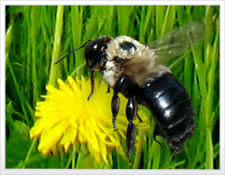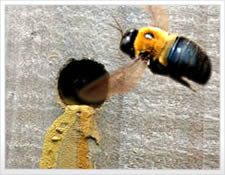Carpenter Bee Control
Prevent Boring Bees from Damaging Your Home or Business
Carpenter Bees are very common in western North Carolina. These large, hairy, and sometimes slow moving bees can be found along the eaves of a home or other wooden structure, and the undersides of decks or porch rails. Their name comes from the fact that they bore holes and tunnel into wood to make their nests – they do not eat wood, however. If you suspect you have a carpenter bee problem, let Go-Forth help you resolve it.

Don't Let Bees Ruin Your Home Contact Us Today!
Carpenter Bee Removal in Western NC
Getting rid of carpenter bees is difficult but not impossible. The first line of defense is for the home owner to keep exposed wooden surfaces stained or painted. This acts as a deterrent to carpenter bees. If acceptable results are not achieved, the next step is proper application of an insecticide to exposed wooden surfaces and treatment of the entrance holes of existing nests. Once treated, it is recommended to seal the tunnels to prevent reuse. Contact a Go-Forth representative through our online form to receive a free estimate.
Carpenter Bee Damage
In small numbers, carpenter bees do not cause serious structural damage. As their numbers increase and they continue to drill tunnels over a number of years, however, more serious damage can occur. Holes on exposed wood surfaces can lead to further damage from fungi and even attacks by other insects like carpenter ants. Carpenter bee eggs and larvae are also a prime target for woodpeckers, which can cause further damage as they search the tunnels for food.

Identifying Carpenter Bees
Carpenter bees are large with black and yellow markings. They are most active in the spring time, and can be mistaken for bumble bees – the most marked difference is their black, shiny tail. Male carpenter bees have no stinger and are usually found hovering around their nests to protect against predators and competitors. They are non-aggressive (except to other male carpenter bees). Female carpenter bees do have the ability to sting if threatened. Their nesting holes are generally around a half inch in diameter.







